Home > About
About Breathe Strong Training
"People have differing preconceptions about 'breathing training'. For some, the association is with clinical rehabilitative techniques that help people to re-learn efficient, diaphragm-focussed breathing; for others, it conjures up associations with techniques that claim to increase everything from your maximal oxygen uptake, to your IQ. Unfortunately, ‘breathing’ is an area that’s become associated with a great of deal pseudo-science, populated by unqualified people, often making outlandish claims. For example, I came across a website recently that provided a case study of a customer who had practiced a particular breathing technique (being promoted by the website), which had apparently led directly to the customer being promoted at work (I kid you not). This is the kind of thing that gets breathing training a bad name. But I’m here to repair the damage."
Professor Alison McConnell, PhD, FACSM, FBASES
Author "Breathe Strong, Perform Better" About the author >
Click the links below for quick access to essential training information on this page:
Introduction
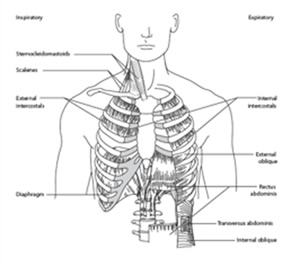
The breathing muscles. From ‘Breathe Strong, Perform Better’, Human Kinetics
In the context of Breathe Strong, breathing training means applying scientifically
validated principles of training theory to the muscles of respiration. The research
underpinning the principles espoused by Breathe Strong can be found in the pages of the
world’s most prestigious scientific journals. Furthermore, the content of breathestrong.com
has been created by the person who has led the way in generating this underpinning research.
So, why train your breathing muscles? Quite simply, because they are muscles.
Breathing is a process that requires the coordinated contraction and relaxation of many muscles.
Research has now shown that the work done by these muscles during exercise is substantial, so their
training status has a profound influence upon exercise performance. There is now ample
research evidence that performance can be improved
by increasing the strength, power and endurance of the inspiratory muscles through specific training.
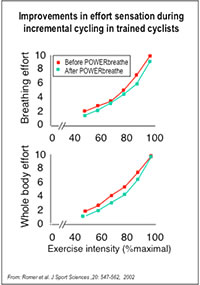
The figure to the right shows the effect of just 6 weeks of inspiratory muscle training
on the perception of breathing and whole body effort in well-trained cyclists. The cyclists
also improved their cycling time trial performance in laboratory simulations by 3.8% (20km)
and 4.6% (40km). That’s almost 2 minutes faster over 40km!
These findings have been confirmed in rowers, runners, swimmers and repeated sprint athletes –
after inspiratory muscle training, they feel that they are working less hard, and their performance improves.

Sir Matthew Pinsent, CBE Quadruple Olympic gold medallist and ten times world rowing champion
“Advances in sport science knowledge are few and far between, but numbered amongst
these rarities is the discovery that breathing has such a profound influence upon performance
that it merits specific training. Even speaking as someone whose lungs were always considered
in the elite range even amongst Olympic oarsmen, I know the benefits that this training can bring. .”
(Extract from the Foreward to ‘Breathe Strong, Perform Better’)
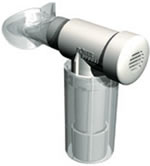
The first POWERbreathe®
How do we train the breathing muscles? Some 20 years ago, I created an inspiratory
muscle trainer that later became known as POWERbreathe®. In 1994, I coined the phrase
“dumbbell for your diaphragm”, which sums up nicely what the POWERbreathe is.
By applying the tried and trusted principles of resistance training, research using
POWERbreathe has shown that these muscles adapt in the same way as other muscles, and
that after as little as 4 weeks, laboratory time trial performance is improved.
Why don’t you already know about breathing training? Breathing training is the best-kept
secret in sport, and even the most progressive and enlightened of scientists and coaches
still don’t fully appreciate how fundamentally the breathing muscles contribute
to performance in sport. Over the course of the past decade, an important cardiovascular
reflex has been discovered. The reflex originates from the breathing muscles, and when it’s activated,
it causes blood flow to the limbs to be restricted. The reflex is activated when the breathing
muscles are forced to work hard during exercise, but the good news is that the intensity of
work required to activate the reflex can be increased by training the inspiratory muscles
(the muscles used to inhale). In other words, athletes can work harder, and longer before
the reflex causes blood flow to be directed away from their limbs. The result is that inspiratory
muscle training improves performance in a wide range of sports and exercise modalities.
What’s more, the role of the breathing muscles in sports movements is even less well
understood than their role in exercise limitation. Let me given you some examples. During
the rowing stroke, the force generated by the extensors of the lower body is transmitted
to the blade handle via the trunk. Without the stabilising action of the breathing muscles
(which are also trunk stabiliser muscles), this linkage would be mechanically inefficient
and the rower would be at a heightened risk of injury. A second example is the role of the
trunk muscles in generating a stable platform, and rotational movement during the action
of swinging a racquet, or bat. The revelation here is that the same muscles that bring
about breathing also stabilise the core and rotate the trunk. This has profound implications
for how we should be training these muscles, which is why I’ve developed a system of
functional breathing training.
Breathe Strong training is undertaken in two phases –
- Foundation training – During Foundation training, the foundations of strength, power and endurance are laid. These foundations provide performance benefits in their own right, but the outcome can be improved still further by placing a functional layer onto these foundations
- Functional training – During functional breathing training, movement specific exercises are used to challenge the inspiratory muscles in their roles as both breathing muscles and as the muscles responsible for postural control, core stabilisation and trunk rotation.
Foundation training
Foundation training is undertaken using an inspiratory muscle trainer such as the POWERbreathe (see Accessories for purchase information). This is your "dumbbell" - as is the case with any form of weight training, there's a right and a wrong way to lift the weight if you want to enjoy maximal reward for minimal effort. In the Foundation phase, there are no special body movements or positions, instead, we isolate the inspiratory muscles to maximise their response to training (later, we can integrate them into functional movements). The following sections guide you through my scientifically validated principles for successful Foundation training.
To find out more about how to assess inspiratory muscle function, and to see some Frequently Asked Questions, click here.
The following information is taken from the book ‘Breathe Strong, Perform Better.’ If you want to know more, then you can buy this comprehensive guide to breathing training by following this link.
Breathing technique
Breath Volume - Although muscle is a very adaptable tissue, training adaptations are also highly specific to the nature of the training stimulus. Adaptations elicited by inspiratory muscle training (IMT) are specific to a number of characteristics of the training stimulus, including the lung volume at which training takes place. The practical implication of this is that IMT should be undertaken across the widest range of lung volumes possible—from the point at which the lungs are as empty as they can be to the point at which it is impossible to inhale any more. Failure to do this will lead to suboptimal adaptation at some lung volumes, which may have a performance impact if these lung volumes are called on during exercise. In addition, loading too heavily can also compromise the breath volume that can be achieved and the amount of work that can be undertaken during training, which will also impair the training response (see below). This impairment occurs because breath volume has a strong influence on the amount of work done per breath, and the training load is the most important determinant of the person’s ability to inhale deeply (see figure). Functional weakening of the inspiratory muscles during inhalation means that if the load is too high, then the inspiratory muscles are not able to overcome the load at higher lung volumes (where the inspiratory muscles are weaker), despite maximal effort. The heavier the load, the more severely the breath is clipped.
Breathing Rate - To understand the advice in this section, you need to know a little about a property of muscle that is known as the force–velocity relationship. Essentially, this property dictates that the faster a muscle contracts, the lower the force it is able to generate. Think about how much less force a person can exert on the pedals when cycling in a low gear compared to a high gear.
We can exploit this property to optimise the training stimulus that the muscle receives. For example, let’s assume that because of the force–velocity properties just described, as the rate of muscle contraction doubles, the strength of the muscle is halved, despite the same (maximal) effort being applied under both conditions. When muscles contract maximally at any speed, the number of muscle fibres that are recruited to the contraction is also maximised, despite the fact that faster contractions result in lower forces. Now let’s look at the effect of doubling the rate of contraction slightly differently. When a muscle is contracting very slowly to move a load that requires half its maximal force-generating capacity, doubling the rate of contraction against the same load would require 100 percent of the muscle’s force-generating capacity (because its ability to generate force would be halved). This means that close to 100 percent of the muscle fibres are recruited—for half the force. This can be turned to our advantage, because it means that it is possible to train at close to 100 percent of a muscle’s force-generating capacity no matter what load is being applied, provided that the load is moved as fast as possible (i.e., with maximal effort). Under any given loading condition, fast muscle contractions recruit more muscle fibres than slow contractions. Therefore, maximal effort ensures maximum velocity and the recruitment of the greatest number of muscle fibres.
Muscle recruitment has an important impact on the response to training for two reasons. First, fibres that are not recruited will not be trained. So, if the velocity of contraction is slow, a load requiring half of a muscle’s force-generating capacity will only require recruitment (and will only train) about half of its fibres. But if the same load is overcome as fast as possible, then close to 100 percent of the fibres will be recruited and trained. Second, maximising recruitment is an important part of the neural adaptation to training, which also contributes to optimising training outcomes. Training improves strength through two mechanisms: stimulating muscle fibres to grow and causing neural adaptations, which ensures the recruitment of all available fibres within a muscle, and that all muscles that contribute to a given movement are recruited.
For muscle fibres to be stimulated to grow (hypertrophy), they need to be subjected to mechanical stress, which requires the application of reasonably heavy loading. This is why high-velocity, low-load training does not improve strength, no matter how much effort is applied at low training loads. The practical implications of this for IMT are that the training load must be at least moderate (50 to 70 percent of maximal strength), and the velocity of contraction (inhalation rate) must be as fast as possible.
Accordingly, IMT should be conducted with maximum effort; in other words, each inhalation should be executed as fast as possible. An inhalation should take 1 or 2 seconds and should be accompanied by a loud rushing sound as air is sucked through the valve of the training device at high velocity. Try to make this sound as loud as possible, because this indicates high flow rates. Be aware that the heavier the load, the slower the maximal flow rate that can be generated. In contrast to the maximal nature of the inspiratory effort, exhalation should be passive and quiet, and it should require 3 or 4 seconds.
Because of the higher-than-normal breath volume and breathing frequency, some light-headedness may result from the hyperventilation. If this happens, pause at the end of exhalation and wait for the urge to breathe in again. More detailed guidance on hyperventilation is provided in the upcoming sections.
Setting the Training Load
The most important determinants of the outcome of any training regimen are the training intensity
and frequency, because these factors define the size of the overloading stimulus to the muscles.
Ironically, these are the two factors that cause people the greatest difficulty in terms of getting
them right. The worst mistake is not overloading the inspiratory muscles sufficiently to elicit
adaptation. But how do you know what intensity and frequency to use?
Setting the training load is actually much easier than people think, provided that a few underlying
principles are understood. Firstly, it’s important to appreciate that the inspiratory muscles
have evolved with an impressive ability to sustain physical work (high endurance), and secondly,
that inspiratory muscle strength is dependent on lung volume (the muscles are strong when the lungs
are empty, but they are weak when the lungs are full). These factors have important implications
for optimising the training regimen.
The high endurance capacity of the inspiratory muscles means that both the number of breaths (repetitions)
and the frequency of training need to be higher than one would normally associate with limb weight training.
For example, a typical strength training regimen for the biceps might involve three sets of eight arm curls,
twice per week, but this regimen would not provide sufficient overload for the inspiratory muscles.
In the foundation phase of IMT, a regimen consisting of 30 breaths, twice daily is required in order
to elicit meaningful changes in inspiratory muscle function for healthy, active young people. The question then
arises about the load setting for these 30 breaths. The load setting is a compromise between a number of factors,
including the fact that the inspiratory muscles become much weaker as we inhale (see figure).
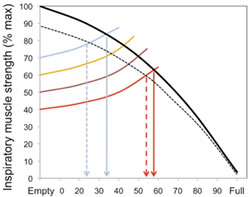
In this figure we can see the interactions between inspiratory muscle strength (black line), different
training loads (40%, 50%, 60% and 70% of maximal inspiratory muscle strength [coloured lines]) and the
breath volume that can be achieved during training, as well as the effect of fatigue (dotted lines).
For example, at 40% it is possible to inhale to around 60% of lung volume, whereas at 70% it is only
possible to inhale to around 35% of lung volume. The dotted lines indicate the effect of fatigue, which
only serves to reduce the volume that can be inhaled further.
All this means that a load setting that was achievable at the onset of inspiration becomes unachievable
partway through the breath, and the effect becomes more exaggerated as the inspiratory muscles fatigue,
leading to breath clipping. If the loading is too heavy, this will have three consequences: Very few
breaths can be achieved because the load cannot be overcome after the first few efforts; the inspiratory
muscles only become trained over a small (low) range of lung volumes (this is detrimental because training
specificity limits the benefits to these low lung volumes); and the amount of work undertaken by the
inspiratory muscles is compromised. Both 1 and 2 have fairly obvious negative impacts on the quality of
the training stimulus and the adaptations that it is able to stimulate, but the third point is less obvious
and requires some further explanation. The practical repercussion of point 3 is that during heavy loading
the amount of work done by the inspiratory muscles is lower than during moderate loading This means that
heavy loading actually provides an inferior training stimulus, which limits its effectiveness.
Research and experience have shown that the best load setting is one equivalent to 50 to 70 percent of the
inspiratory muscle strength. This setting provides the widest range of benefits and the greatest level of
comfort during training. But how do you know what setting this is on your breathing muscle trainer?
It’s simpler than you may think and can be achieved by applying the tried-and-trusted “rep
max” principle from weight training. In other words, you find the load setting that allows you
to achieve the number of reps that your training regimen requires. The trick with IMT is knowing how
many reps (breaths) correspond to a load of 50 to 70 percent; once again, research provides the answer -
the golden number to be around 30.
For the first training session, the best plan is to set the training load to the lowest setting on the
training device and to complete 30 breaths, concentrating on developing good breathing technique
(as described previously). If the first training session felt very easy, increase the load on the training
device by one setting for the second training session of the day. With each training session, continue to
increase the load until a setting is achieved that only allows you to complete 30 breaths (see also the
upcoming Repetition Failure). Remember, the inspiratory phase must be executed with maximal
effort (inhale as fast as possible against the load), but the expiratory phase should be slow and relaxed.
The breathing pattern during IMT (fast inhalation with maximal volume) can induce some dizziness due to
hyperventilation and loss of carbon dioxide from the blood. This is harmless for the duration of a
30-breath workout, and it also seems to lessen in severity as training progresses. If the dizziness
does become unpleasant at any time, simply pause at the end of the next expiration and wait for the
urge to breathe in. For maximal training overload, the training breaths should be completed as quickly
as possible, but this has to be balanced against the dizziness. A trick that can be used to overcome
the loss of carbon dioxide is to place the training device inside a bag that has a slit down one side
(a grocery bag is ideal). When you exhale and inhale from the bag (rebreathing), the loss of carbon
dioxide is largely abolished, and dizziness is prevented. This allows you to complete the breaths rapidly,
maximising the training benefits.
When athletes are advised to undertake IMT twice per day, they often ask whether an even better result
can be achieved by training three or even four times per day. The answer is emphatically no. Recovery
is an important part of the training process, and the inspiratory muscles are already being subjected
to a very challenging regimen of specific IMT twice per day, plus the work of breathing during other
training. People should not be tempted to do IMT more than twice daily, and they should ensure that
the two sessions are separated by at least 6 hours.
Repetition Failure
Although the target number of breaths is 30 (the 30RM), overload can be maximised by training beyond
this threshold as soon as the inspiratory muscles are able to sustain the effort—in other words,
if you get to 30 and feel as if you still have a few more breaths in you, you should go for it
(see later for advice on progressing the load). However, most people find it difficult to determine
precisely when they have reached a point where they cannot continue (i.e., when they reach “failure”).
As the training session progresses and fatigue sets in, each breath becomes progressively shallower than the
previous one. This is a direct result of the fact that the inspiratory muscles are stronger at the start
of the breath than at the end (see figure above)—because of this, fatigue is expressed first at higher
lung volumes, and successive breaths are “clipped” at a lower breath volume. Eventually, a point
is reached where it may be possible to open the valve, but not possible to take a meaningful breath. This
is very different from an exercise such as a biceps curl, where the biceps are weakest at the onset of
the exercise, which means that failure is much easier to identify because the rep cannot be started.
So how is repetition failure defined for IMT? Once it’s impossible to achieve a “satisfying
breath,” then it’s time to stop. Another trick can also be used to ensure that failure is achieved
on every training session; once 30 breaths have been completed, the load setting on the training device
should be increased by half a turn with each successive breath (do this during the exhalation). This
rapidly brings you to the point where the valve cannot even be opened—job done (don’t forget to
return the setting to the correct load for your next training session).
If your aim is to improve your exercise performance, the importance of training to failure for optimal results
cannot be overstated. If training ceases before failure is achieved, then the training intensity has been
suboptimal, and the training adaptations will be similarly suboptimal. As with any other kind of training,
those people with the greatest commitment to achieving 30 breaths at the highest load possible—and who
don’t loaf by skipping sessions—always reap the best rewards in terms of the improvements that they
achieve. Like most things in life, you reap what you sow.
Influence of Concurrent Training
If IMT is being undertaken concurrently with other training, some variation will likely be seen in the
number of breaths that can be achieved before “failure” in the IMT sessions. This is because
the inspiratory muscles will have different work histories, depending on the demands that have been
placed on them by the other training that is being undertaken. Therefore, it’s perfectly normal
for an evening training session to involve fewer breaths to failure at a given load than a morning
session. Accordingly, if an evening session has been especially challenging, you should not
reduce the training load before the next session, because the inspiratory muscles will have largely
recovered by the next morning. However, if you fail to complete 30 breaths for more than three training
sessions, a small reduction in load should be made, because this may be a sign of overtraining of the
inspiratory muscles. This kind of overtraining leads to severely impaired adaptation and a very poor
overall result. If you suspect that there is any residual fatigue of the inspiratory muscles, take a day off from IMT.
However, undertaking IMT immediately after a whole-body training session can also be a very effective
method of introducing specificity into your IMT. After a whole-body training session, your inspiratory
muscles will be slightly fatigued. If IMT is undertaken when the inspiratory muscles are in this state,
those muscles that have worked hardest during the preceding whole-body session will receive the greatest
training stimulus. This approach is best introduced after about 4 weeks of foundation IMT, three or four times per week.
Just as whole-body training can influence the ability of the inspiratory muscles to tolerate IMT, so too
can IMT influence the person’s ability to perform whole-body training. Indeed, much of the evidence
for an effect of inspiratory muscle fatigue on performance was based on prefatiguing the inspiratory
muscles and noting a decrement in performance. The implications of this are clear for people engaged
in concurrent training; they must be mindful of the interaction between the two forms of training.
No athlete or coach would schedule a heavy squat session immediately before a cycle time trial—it’s
not rocket science, just common sense.
Progressing Training
After training at a given load setting for a few days, you will find it progressively easier to achieve —and
then to exceed—the 30-breath target. This is because the inspiratory muscles begin to adapt immediately to
the training stimulus by increasing their strength and endurance. Therefore, to maintain the overloading
stimulus, the person must increase the load setting at least once per week during the first 6 weeks.
Without these increases, continued adaptation will cease.
The increase in load should be sufficient to reduce the number of breaths that can be achieved before
failure to between 25 and 30. On most training devices, this will be about one-quarter to one-half
turn on the spring tensioner. Bringing the number of breaths down to 25 is acceptable, because within
a few days, the maximum number of breaths will be back up to 30.
As a general rule, the training load should be increased by at least one-quarter turn each week for
the first 6 weeks of training (i.e., during the foundation phase). Alternatively, small increases can
be made as soon as the maximum number of breaths exceeds 33.
Keeping a training diary is a good way to keep track of the number of sessions completed, the increments in
training load, the number of breaths completed, and how the session felt.
Click here
to download a Breathe Strong trianing diary template. Note that there is space for notes about how the
training felt and other activities that were undertaken on the same day. This facilitates cross-referencing
of circumstances that may be helpful for the athlete and coach in interpreting sudden up- or downturns in
training quality.
When foundation training has been completed, you can switch to maintenance training, or training can be
developed further using Breathe Strong functional training exercises.
Foundation IMT Essentials
- Set the training load to the 30-repetition maximum (30RM) using a process of trial and error.
- Inhale against the load with maximum effort (as fast as possible).
- Breathe in AND out as far as possible during each breath.
- Train twice per day—morning and evening.
- Remember that repetition failure for the inspiratory muscles is an “inability to achieve a satisfying breath.”
- Progress the training by keeping the load at your new 30RM to account for improvement (increase the load at least once per week).
- Train in a window between 25 and 35 breaths per session.
- Keep in mind that whole-body training may affect IMT because of residual fatigue, so evening IMT sessions may be more challenging than morning sessions—but don’t reduce your training load.
- If you suspect that there is any residual fatigue of the inspiratory muscles, take a day off from IMT.
- Don’t do IMT just before a big training session or competition.
- Keep an IMT diary.
Top Tips for optimal results
- Tip 1: Place the training device in a bag so that rebreathing can occur. This allows for fast sets with no dizziness.
- Tip 2: Ensure “failure” by increasing the load by half a turn on each successive breath after 30.
- Tip 3: Unload the inspiratory muscles during training by leaning forward and resting your hands on your knees or a chair back.
- Tip 4: After about 4 weeks of IMT, perform your training immediately after a whole-body training session three or four times per week (to introduce specificity).
If you found this section useful, then find out more in my comprehensive guide to breathing training - ‘Breathe Strong, Perform Better’. Follow this link to purchase.
Breathing muscle assessment
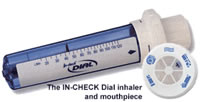
Inspiratory muscle strength is assessed by measuring the maximal pressure that can be generated during a maximal inspiratory effort against an occluded airway. This is a ‘gold standard’ measurement in research, but the equipment and expertise necessary to make this measurement reliably are beyond the reach of most people. But all is not lost, because peak inspiratory flow rate (the maximal rate of inhalation) is closely correlated with inspiratory muscle strength. By measuring this flow rate, you can monitor improvement in your inspiratory muscle performance indirectly. The product I recommend for measuring peak flow is one that was developed for assessing people’s ability to breathe in through an asthma inhaler, but it does the job of measuring peak flow very well. If you multiply your peak inspiratory flow rate by 18, you can estimate your inspiratory muscle strength (measured in centimetres of water pressure). For example, if your peak inspiratory flow rate is 7 litres per second, then your predicted inspiratory muscle strength is 126 cmH2O. See my Training Accessories page for purchasing information.

The POWERbreathe K-Series inspiratory muscle training products also measure peak inspiratory flow rate,
and estimate inspiratory muscle strength automatically to give you a “strength index”
(also in cmH2O). These clever training devices also use the data to automatically
individualise training loads (see www.powerbreathe.com
for further information of the K-Series).
Typical values for inspiratory muscle strength are difficult to provide, because this index varies widely
in perfectly healthy people of similar age, body size and fitness. However, as a rough rule of
thumb, young, well-trained men and women should have inspiratory muscle strength in the order of
150 cmH2O and 120 cmH2O, respectively. My research has shown that this baseline
value is fairly meaningless, much more important is the extent to which this measurement can be
increased. Typically, 25-45% increases are achievable within 4 to 6 weeks of commencing Foundation training.


